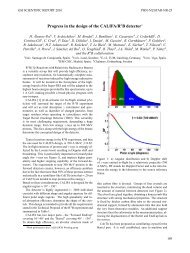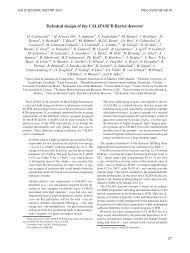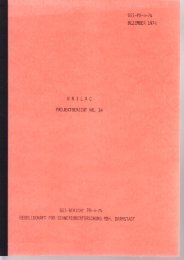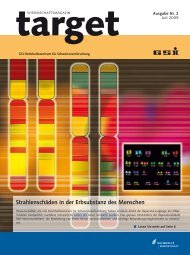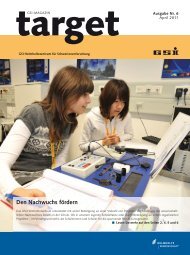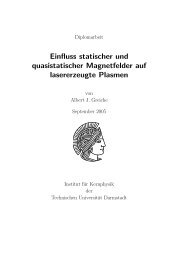download block - GSI Helmholtzzentrum für Schwerionenforschung
download block - GSI Helmholtzzentrum für Schwerionenforschung
download block - GSI Helmholtzzentrum für Schwerionenforschung
You also want an ePaper? Increase the reach of your titles
YUMPU automatically turns print PDFs into web optimized ePapers that Google loves.
NUSTAR-SHE-01 <strong>GSI</strong> SCIENTIFIC REPORT 2009<br />
an α-like event with properties as exhibited by the observed<br />
one is only 0.1%. We thus assign it to a so far unobserved<br />
α-branch in 281 Ds. Considering this α-decay and<br />
the thirteen measured SF decays from [1] and our work,<br />
an α-decay branch bα of<br />
16<br />
9 7<br />
+ − % results after correcting<br />
for detection efficiency differences for α-decay and SF.<br />
The chain was terminated 4.5 ms later by SF of the new<br />
nucleus 277 Hs.<br />
The B•ρ of element 114 EVRs in 0.8 mbar He was<br />
measured to (2.29±0.11) T•m.<br />
Figure 1: Decay chains assigned to 288 114 (chains 1-8)<br />
and 289 114 (chains 9, 10) observed during the 42-MeV<br />
run. A black triangle in the lower right corner of a box<br />
indicates that the beam was off at the time of the event.<br />
Figure 2: Same as Figure 1, but showing decay chains<br />
observed during the 38-MeV run.<br />
Table 1. Decay properties (this work combined with [1])<br />
Isotope Decay T1/2 (this work) T1/2 (combined)<br />
289<br />
114 α 0.97<br />
0.97 0.<br />
32<br />
+ − s<br />
288<br />
114 α 0.24<br />
0.47 0.<br />
12<br />
+ − s<br />
285<br />
112 α 30<br />
30 10<br />
+ − s<br />
284<br />
112 SF 50 101 25<br />
+ − ms<br />
281<br />
Ds SF/α:91/9 20 20 7<br />
+ − s<br />
277<br />
Hs SF 15<br />
3 1<br />
+ − ms<br />
170<br />
0.8<br />
2.1 0.<br />
4<br />
+ − s<br />
0.17<br />
0.69 0.<br />
11<br />
+ − s<br />
11<br />
29 6<br />
+ − s<br />
24<br />
99 16<br />
+ − ms<br />
5<br />
13 3<br />
+ − s<br />
15<br />
3 1<br />
+ − ms<br />
Discussion<br />
Z=108 is a deformed proton shell closure in N~162 isotopes.<br />
The observed 277 Hs lifetime is short compared to<br />
half-lives of the Hs isotopes near the deformed N=162<br />
shell closure, indicating reduced shell stabilization in the<br />
N=169 nucleus 277 Hs. Macro-microscopic model predictions<br />
of T1/2(SF) for the neighboring isotopes are 46 ms<br />
( 276 Hs) and 0.98 ms ( 278 Hs), the geometric mean being 6.7<br />
ms [13]. This is similar to our observed lifetime. The odd<br />
neutron is expected to hinder SF decay significantly.<br />
Thus, the drop in T1/2(SF) when increasing N above 162<br />
may be more severe than suggested by [13]. 275 Hs<br />
(N=167) decays by α-particle emission with T1/2=0.19 s<br />
[1]. The experimental trend with prevalent α-decay in Hs<br />
isotopes with N=157-167, but predominant SF in lighter<br />
as well as in heavier isotopes is close to that in [10],<br />
which suggests dominant α-decay from N=154 to N=166<br />
but SF for N>168. This indicates that stability vanishes<br />
rapidly with increasing distance from N=162.<br />
Measured cross sections for element 114 isotopes in the<br />
. 4<br />
. 2<br />
38-MeV run were<br />
7<br />
8.0 4.<br />
5<br />
+ 4<br />
− pb (3n channel) and 2.8 2.<br />
1<br />
+ − pb<br />
(4n channel), and in the 42-MeV run,<br />
3. 9<br />
1<br />
3. 3<br />
3.5 2.<br />
0<br />
+ − pb (3n<br />
channel) and 9.8 3.<br />
+ − pb (4n channel). Error bars include<br />
statistical uncertainties only (68.3% confidence level); the<br />
systematic uncertainty is estimated to 14%. In contrast to<br />
any other confirmation experiment, we confirm the large<br />
cross sections as reported from FLNR [1]. In fact, our<br />
measured cross sections are higher than those reported<br />
from the DGFRS. These high cross sections call for investigations<br />
of the details of the production mechanism.<br />
Production rates that follow from these values encourage<br />
using this nuclear reaction to produce relatively longlived<br />
isotopes of element 114, in particular for envisaged<br />
chemical investigations [14] or for γ-spectroscopic studies<br />
that allow shedding light on the nuclear structure in this<br />
SHE region and may facilitate unique Z identification.<br />
We thank the ECR and UNILAC staff for excellent<br />
48<br />
Ca beams and H. Brand and the <strong>GSI</strong> EE department, the<br />
machine shop staff at the institute of radiochemistry, TU<br />
Munich, and V. Gorshkov for technical support.<br />
References<br />
[1] Yu.Ts. Oganessian, J. Phys. G 34 (2007) R165.<br />
[2] S. Hofmann, EPJA 32 (2007) 251.<br />
[3] R. Eichler et al. Nature 447 (2007) 72.<br />
[4] L. Stavsetra et al., PRL 103 (2009) 132502.<br />
[5] S. Hofmann, Lect. Notes Phys. 264 (2009) 203.<br />
[6] M. Schädel, Eur. Phys. J. D 45 (2007) 67.<br />
[7] A. Semchenkov et al., NIM B 266 (2008) 4153<br />
[8] A. Gorshkov et al., in preparation for NIM A.<br />
[9] K.E. Gregorich et al., <strong>GSI</strong> Sci. Rep. 2006 (2007) 144.<br />
[10] Ch.E. Düllmann et al., submitted to PRL.<br />
[11] J.M. Gates et al., in preparation for PRC.<br />
[12] H.G. Essel et al., this Scientific Report.<br />
[13] R. Smolanczuk, PRC 52 (1995) 1871.<br />
[14] A. Yakushev et al., this Scientific Report.





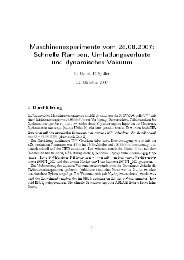
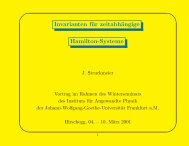
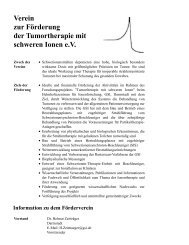
![GS I -P-]-17 - GSI Helmholtzzentrum für Schwerionenforschung](https://img.yumpu.com/20698964/1/184x260/gs-i-p-17-gsi-helmholtzzentrum-fur-schwerionenforschung.jpg?quality=85)

